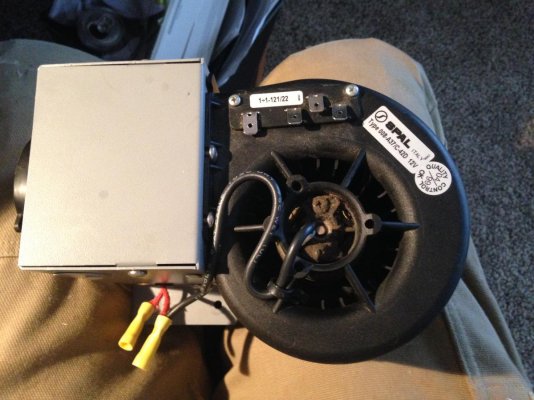jungpeter
Guru
As the owner of a newly-acquired Pacific Trawler 40, I am confronted by the usual assortment of "warts". One of which is the propensity of my pilothouse window defroster to continuously trip the breaker that controls its operation. Upon opening the overhead cabinet that houses the defroster, I am confronted with a cramped installation (its a boat! what do I expect?), and absolutely no information regarding the make or model for the defroster. And, as it's constrained by the wiring, it is difficult to remove in order to gain full view of the unit.
My clamp meter confirms that is does, indeed, draw 24A at 12VDC, which is more than enough to trip the 20A circuit breaker it is connected to. Inspection of the defroster confirms the location of the 12VDC wiring. However, there appears to be an additional 110VAC 3-wire connection as well. That connection is inaccessible without removing the defroster, which will require cutting all the wires to get at the beast.
So... here's one question. Does any Pacific Trawler owner of around the 2000 year vintage have any documentation regarding the defroster unit I might have? I've searched the WWW, and found several that "look" like mine, but as I can't see a manufacturers data plate on mine, I can't confirm much. Nor is a telephone call to the various manufacturers particularly productive, as I can't confirm it's actually one of theirs!
Second, my defroster has both a centrifugal ("squirrel cage") fan providing the air flow, and a down-stream heating element. I can't tell if the heating element is getting hot, as the breaker trips after only a few seconds of operation. And I have no idea if the element is heated with 12VDC or 110VAC.
Third, if (as I suspect) the fan is the only power draw on the 12VDC circuit, why would the fan draw 24A? Heck, that's almost 1/3 hp, which seems excessive for this application.
And lastly, if both the fan AND the heater use 12VDC, whatineck is the 110VAC circuit for???
I be confusticated, and any insight would be appreciated before I perform surgery on the defroster to yank it out and sit it on my bench for R&R.
Regards,
Pete
My clamp meter confirms that is does, indeed, draw 24A at 12VDC, which is more than enough to trip the 20A circuit breaker it is connected to. Inspection of the defroster confirms the location of the 12VDC wiring. However, there appears to be an additional 110VAC 3-wire connection as well. That connection is inaccessible without removing the defroster, which will require cutting all the wires to get at the beast.
So... here's one question. Does any Pacific Trawler owner of around the 2000 year vintage have any documentation regarding the defroster unit I might have? I've searched the WWW, and found several that "look" like mine, but as I can't see a manufacturers data plate on mine, I can't confirm much. Nor is a telephone call to the various manufacturers particularly productive, as I can't confirm it's actually one of theirs!
Second, my defroster has both a centrifugal ("squirrel cage") fan providing the air flow, and a down-stream heating element. I can't tell if the heating element is getting hot, as the breaker trips after only a few seconds of operation. And I have no idea if the element is heated with 12VDC or 110VAC.
Third, if (as I suspect) the fan is the only power draw on the 12VDC circuit, why would the fan draw 24A? Heck, that's almost 1/3 hp, which seems excessive for this application.
And lastly, if both the fan AND the heater use 12VDC, whatineck is the 110VAC circuit for???
I be confusticated, and any insight would be appreciated before I perform surgery on the defroster to yank it out and sit it on my bench for R&R.
Regards,
Pete


